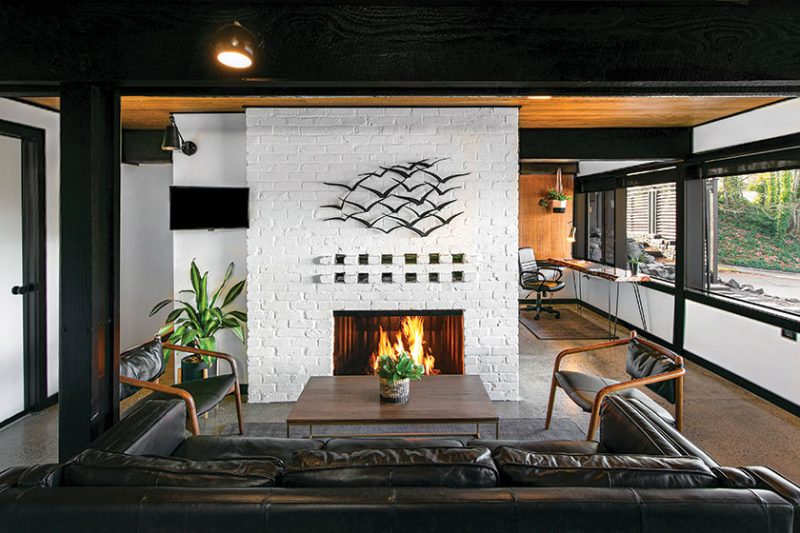A historical preservationist in West Seattle sees restorations as both an honor and responsibility and brought both to this project for his family home.

A chapter of Mid Century Modern history can be found nestled in Puget Sound in West Seattle, which is located on a peninsula across from downtown Seattle. It’s a predominately MCM neighborhood, and it’s perched above a ferry dock, combining enduring examples of the genre with a scenic setting. It’s very much its own place.

According to historical preservationist Padraic Slattery of Permanent Vacation Design, “West Seattle very much carries itself with a ‘chip on its shoulder’ in comparison the rest of the city. To a gradually diminishing degree, West Seattle has a persona of Seattle from back in the 1990s, long before the tech boom.”


When it comes to projects such as this one, Padraic brings his expertise on both the area and MCM design to the proverbial restoration table.
“Restorations such as this are an honor, but they also carry a debt of responsibility to the neighborhood and the original designers,” he says. “These structures deserve to be reinvigorated with period details in mind. Otherwise, history is being defaced.” He and his team of four handle history with care, and each project clearly shows that.
Restoring a Puget Sound Home by Embodying MCM Style
MCM design is close to Padraic’s heart and reminds him of his grandfather’s era in Portland, Oregon. His grandfather enjoyed frequenting iconic places such as the Fish Grotto, Alibi Room and the Ringside. And, just as his grandfather was, Padraic was shaped by an establishment that embodies the genre.

“I truly fell in love with Mid Century Modern design at Vito’s Restaurant in Seattle,” he explains.
The restaurant boasts a storied past as a Mafia hangout and is decked out in original MCM design to this day.
“I’m profoundly inspired by Mid Century Modern style, and I’m so grateful for the impact it has had on my life and career,” Padraic says.
He loves the elaborate exterior signs, finish materials, light fixtures and other “atomic” features of the era.
“You can do some amazing things with new construction, but you just can’t replace history. There is something special about it, and I’m addicted to restoring these structures.”
That Gut Feeling
Padraic and his family weren’t even in the market for a new place, but when they saw this 1957 house, they knew it would be their next home.
“It struck an instant chord with us—namely because of the gabled roof line, staircase, window wall and the retractable shoji screen wall feature. I had that ‘feeling’ that’s undeniable, and I never bet against my gut feeling.”


The fundamental objectives of the renovation were to pay homage to the architect by performing a historically accurate restoration of the home and respectfully enhancing its functionality for today’s modern family.
“The temptation of current design trends wasn’t considered, because I felt this home deserved to be preserved in a historical context,” Padraic explains.
Puget Sound Restoration: Reno Objectives
The fundamental goals of this renovation were to pay homage to the architect by performing a historically accurate restoration of the home and respectfully enhancing its functionality for today’s modern family. It was engineered in a two-phase schedule.

The design was envisioned in 2019, but it wasn’t fully implemented until 2021. The bulk of the construction work was completed within a window of five months. And, because the home was built in 1957, it suffered from outdated systems that required updating.
“The most challenging obstacle was replacing the plumbing system and removing the masonry block retaining wall that buried the original basalt rockery in the front of the house,” Padraic shares.


Reengineering the driveway and the staggered entry steps proved to be a difficult task; it was an unforeseen, impromptu project.
For the design, Padraic wanted to make a bold, contrasting statement with the exterior matching the interior, along with a complementary landscape, enhanced by the incorporation of subtle Asian design touches throughout the property.
Asian Influences
“Northwest Mid Century Modern architecture commonly features shoji screen details—a design element driven by famed architect Paul Kirk. This house fell in line via an entire retractable custom shoji screen wall spanning two floors.” The wall was meticulously restored with acrylic shoji screens sourced from Japan.


To reinforce the exterior, the simplified landscape features extensive use of rock mulch that’s supported by bamboo and pom pom pine trees. The Asian touches are a natural extension of the family (the Slatterys comprise a predominately Asian household). Also, in the Pacific Northwest, Asian design and MCM design go hand in hand. The influence of Japanese architecture is undeniable in many mid-century homes in the area.


The home is a wonderful MCM haven. It showcases the functionality of the homes that were built 60 years ago and how they still meet the layout demands of today’s modern lifestyle.

“Furthermore, the architectural effort and creativity applied then is still more creative than the ‘box’ mentality of newly built modern homes of today,” Padraic points out. “That’s what draws us to Mid Century Modern designs; and we are so happy with how ours turned out.”
What’s the connection between Pacific Northwest Modernism and Asian Design? Learn more about Pacific Northwest MCM Style and see this home where Zen Meets Mid Mod. Don’t forget to follow us on Instagram, Facebook and Pinterest for more Atomic Ranch articles and ideas!












